Zone 7 Trees
Vitex agnus-castus
Chaste Tree
Family Verbenaceae
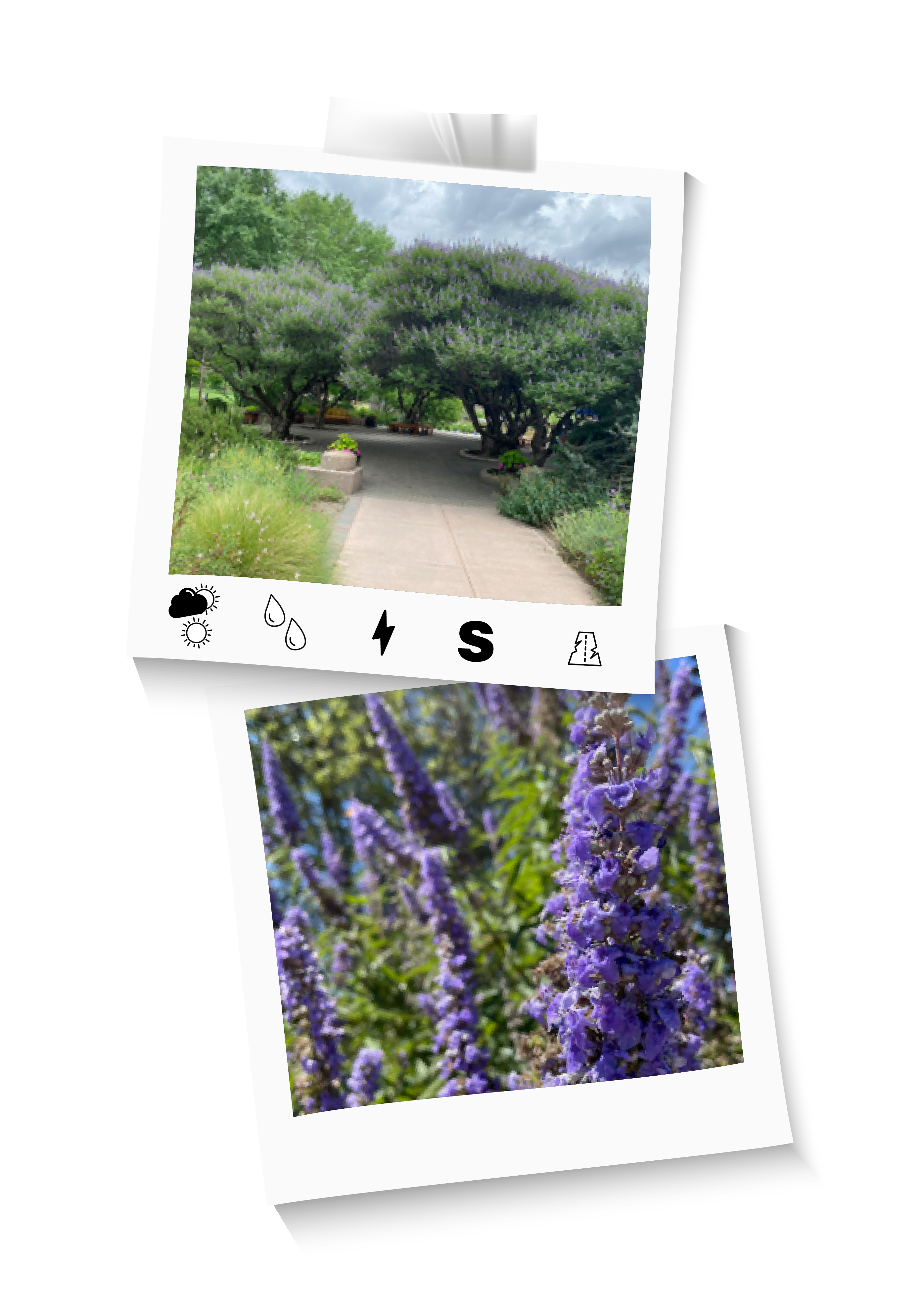
SelecTree. UFEI. “Vitex agnus-castus Tree Record.” 1995-2022. Cal Poly State University, San Luis Obispo. Accessed on Jul 19, 2022.
< https://selectree.calpoly.edu/tree-detail/1464 >
Site Conditions
- Planting area: 2’ – 5’
- Root Damage Potential: Low
- SelecTree Water Use: Low
- USDA zones: 6, 7, 8, 9, 10
- Sun exposure: Partial Shade to Full Sun
- Soil texture: Loam, Sand, or Clay
- Soil pH: Very Acidic to Very Alkaline
- Soil salinity tolerance: Good Inland
- Powerline friendly: Yes
Tree Characteristics
- Tree Shape: Rounded
- Foliage type: Deciduous
- Maximum height: 15 feet
- Canopy width: 15-20 feet
- Growth rate: ~24 in/year
- Flowers: Showy, Fragrant
- Flower color: Blue or Lavender
- Flowering: Summer or Fall
- Fruit: Small Black Drupe
- Fruiting: Summer or Fall
- Litter: Dry Fruit
Site Consideration
Streetscape, Screen, and Tree Specimen
Cedrus deodara
Deodar Cedar
Family Pinaceae

Photos taken at Fresno, CA, Huntington Botanical Gardens – San Marino, CA, Strybing Arboretum – San Francisco, CA, Bakersfield, CA, Los Altos, CA, Stanford University – Palo Alto, CA and UC Santa Cruz Arboretum – Santa Cruz, CA by M. Ritter, W. Mark, J. Reimer, C. Stubler
Site Conditions
- Planting area: 10’
- Root Damage Potential : Moderate
- SelecTree Water Use: Medium
- USDA zones: 7, 8, 9
- Sun exposure: Partial Shade to Full Sun
- Soil texture: Loam, Sand, or Clay
- Soil pH: Very Acidic to Very Alkaline
- Soil salinity tolerance: Moderate
- Powerline friendly: No
Tree Characteristics
- Tree Shape: Conical
- Foliage type: Evergreen
- Maximum height: 60 feet
- Canopy width: 20-30 feet
- Growth rate: ~36 in/year
- Flowers: Fragrant
- Flowering: Fall
- Fruiting: Spring
- Litter: Large Green and Brown Cone
Site Consideration
Parkland, Wildland, Tree Specimen
Parkinsonia x ‘Desert Museum’
Desert Museum Palo Verde
Family Fabaceae
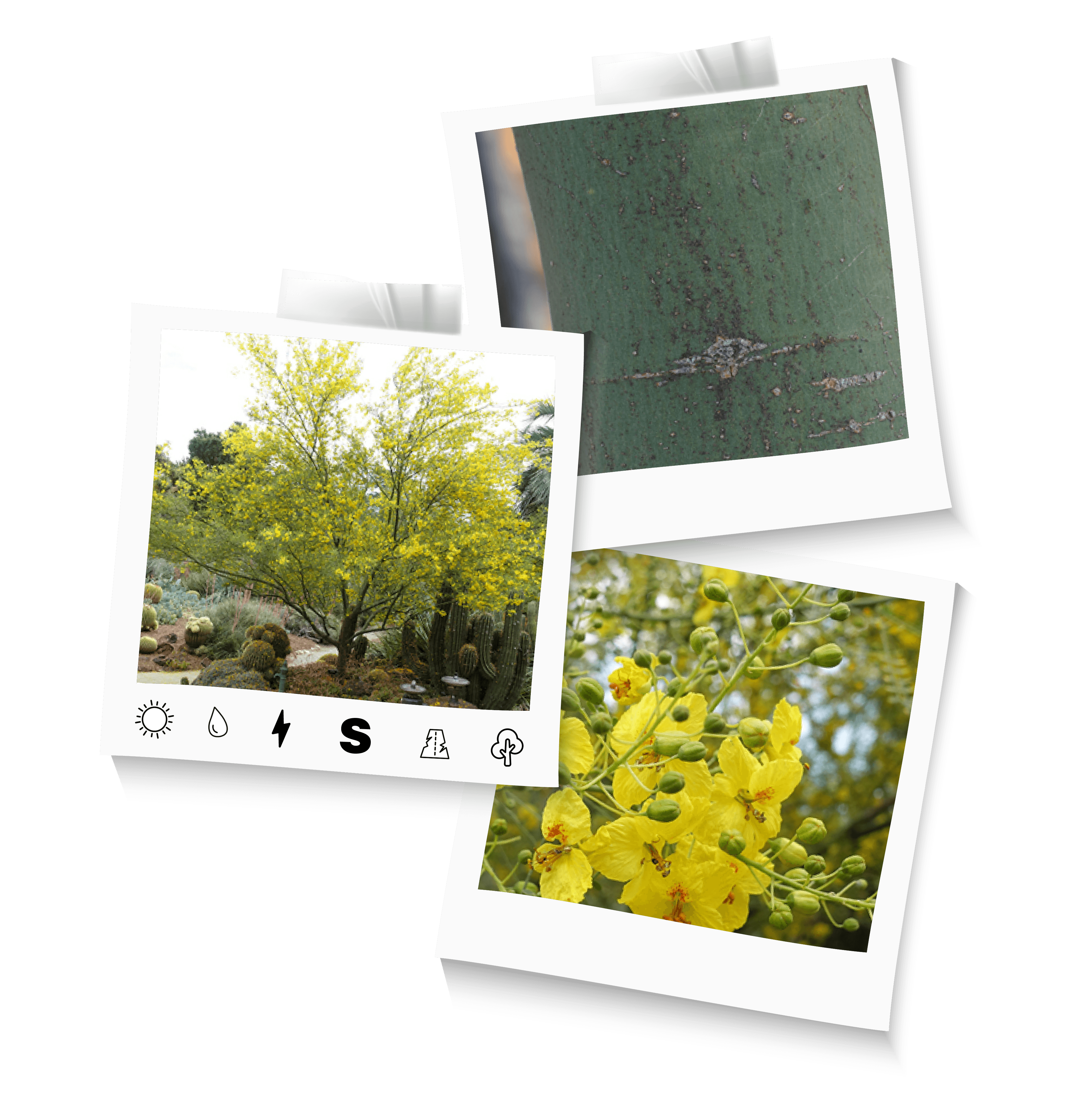
Photos taken at Pasadena, CA, Huntington Botanical Gardens – San Marino, CA, Cal Poly – San Luis Obispo, CA and UC Davis, Davis, CA by M. Ritter, J. Reimer
Site Conditions
- Planting area: 2’ – 5’
- Root Damage Potential: Low
- SelecTree Water Use: Very Low
- USDA zones: 6, 7, 8, 9
- Sun exposure: Full Sun
- Soil texture: Loam, Sand, or Clay
- Soil pH: Neutral to Very Alkaline
- Soil salinity tolerance: Inland Good
- Powerline friendly: Yes
Tree Characteristics
- Tree Shape: Rounded
- Foliage type: Deciduous
- Maximum height: 20 feet
- Canopy width: 20-25 feet
- Growth rate: ~24-36 in/year
- Flowers: Showy, Fragrant
- Flower color: Yellow
- Flowering: Spring or Summer
- Fruit: Large Brown Legume
- Fruiting: Fall
- Litter: Dry Fruit
Site Consideration
Streetscape, Screen, and Tree Specimen
Tilia cordata
Littleleaf Linden
Family Tiliaceae

http://selectree.calpoly.edu/tree-detail/1408#:~:text=Photos%20taken%20at,Mark%2C%20J.%20Reimer
Site Conditions
- Planting area: 10’
- Root Damage Potential: Moderate
- SelecTree Water Use: Medium
- USDA zones: 4, 5, 6, 7, 8
- Sun exposure: Partial Shade to Full Sun
- Soil texture: Loam, Sand, or Clay
- Soil pH: Very Acidic to Slightly Alkaline
- Soil salinity tolerance: Moderate
- Powerline friendly: No
Tree Characteristics
- Tree Shape: Rounded
- Foliage type: Deciduous
- Maximum height: 60 feet
- Canopy width: 15-30 feet
- Growth rate: ~12-24 in/year
- Flowers: Showy, Fragrant
- Flowering: Summer
- Fruiting: Fall
- Litter: Small Dry Fruit
Site Consideration
Streetscape, Tree Specimen, Parkland
Cornus nutallii
Mountain Dogwood
Family Cornaceae
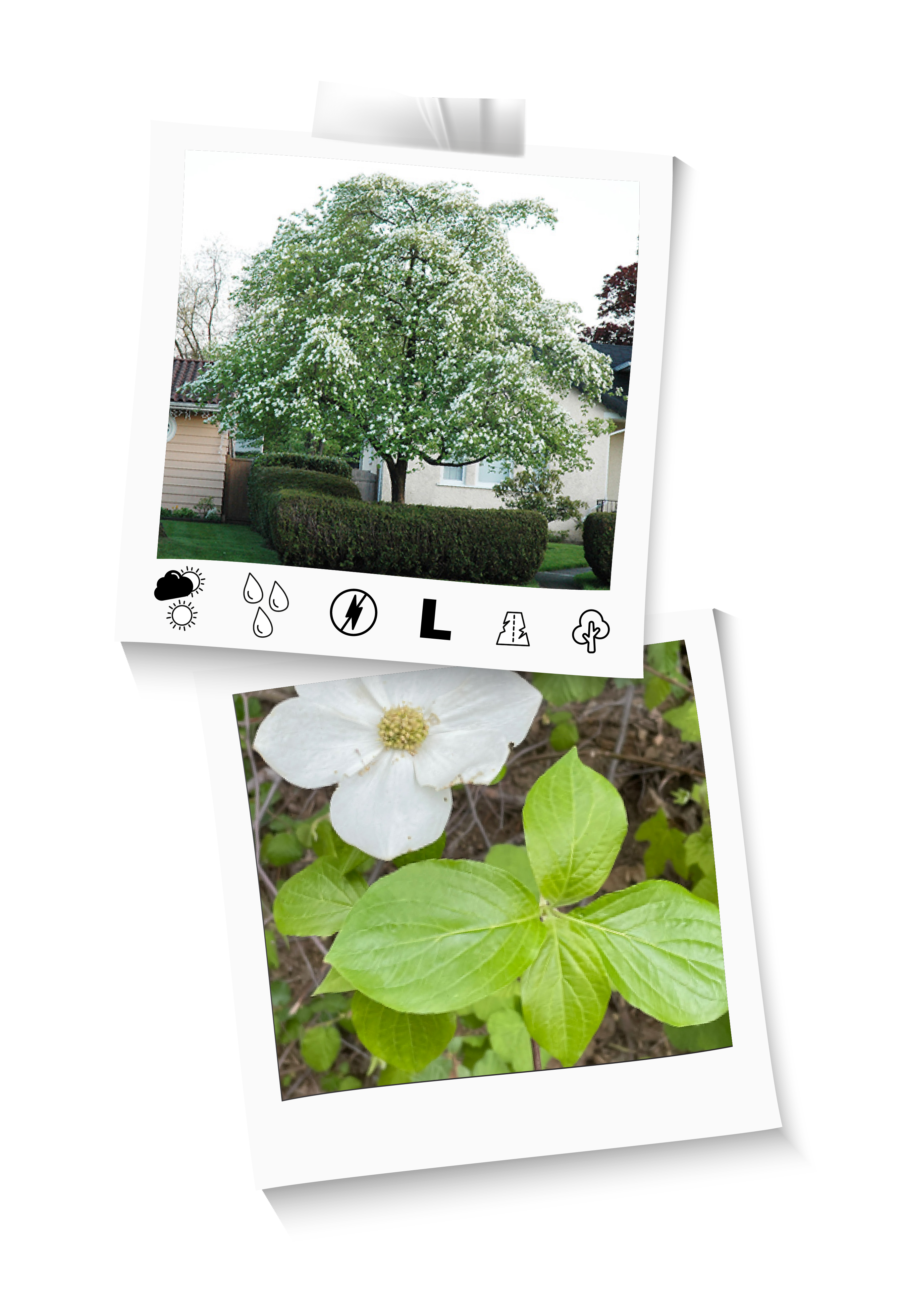
http://plants.squakmtnursery.com/12230001/Plant/11591/Pacific_Dogwood/, Tilden Regional Parks Botanical Garden – Berkeley, CA and Hoyt Arboretum – Portland, OR by J. Reimer, M. Ritter
Site Conditions
- Planting area: <10’
- Root Damage Potential: Low
- SelecTree Water Use: Medium
- USDA zones: 7, 8
- Sun exposure: Full Shade to Partial Shade
- Soil texture: Loam or Clay
- Soil pH: Very Acidic to Neutral
- Salt spray tolerance: Moderate
- Powerline friendly: No
Tree Characteristics
- Tree Shape: Vase
- Foliage type: Deciduous
- Maximum height: 50 feet
- Canopy width: 20-25 feet
- Growth rate: ~24 in/year
- Flowers: Showy, Fragrant
- Flower color: White
- Flowering: Spring or Fall
- Fruit: Small Orange or Red Drupe
- Fruiting: Spring or Fall
- Litter: Dry Fruit
Lagerstroemia ‘Natchez’
Natchez Hybrid Crape Myrtle
Family Lythraceae

Photos taken at Dallas Arboretum – Dallas, TX, Cohn Arboretum – Baton Rouge, LA, Independence Park Botanic Garden – Baton Rouge, LA, River Banks Botanical Garden – Columbia, SC and The National Arboretum – Washington, DC by W. Mark, J. Reimer, C. Stubler
Site Conditions
- Planting area: 5’-10’
- Root Damage Potential: Low
- SelecTree Water Use: Medium
- USDA zones: 7, 8, 9, 10
- Sun exposure: Partial Shade to Full Sun
- Soil texture: Loam, Sand, or Clay
- Soil pH: Very Acidic to Slightly Alkaline
- Salt spray tolerance: Moderate
- Powerline friendly: Yes
Tree Characteristics
- Tree Shape: Rounded or Vase
- Foliage type: Deciduous
- Maximum height: 25 feet
- Canopy width: 15-25 feet
- Growth rate: ~12-24 in/year
- Flowers: Showy
- Flower color: White
- Flowering: Summer
- Litter: Dry Fruit Capsules
Site Consideration
Screen, Tree Specimen
Catalpa speciosa
Northern Catalpa
Family Bignoniaceae

Photos taken at National Arboretum – Washington, D.C., Los Angeles County Arboretum – Arcadia, CA, by M. Ritter, W. Mark, J. Reimer
Site Conditions
- Planting area: < 10’
- Root Damage Potential : Moderate
- SelecTree Water Use: Medium
- USDA zones: 4, 5, 6, 7, 8
- Sun exposure: Full Shade to Full Sun
- Soil texture: Loam, Sand, or Clay
- Soil pH: Very Acidic to Very Alkaline
- Soil salinity tolerance: Moderate Inland
- Powerline friendly: No
Tree Characteristics
- Tree Shape: Rounded
- Foliage type: Deciduous
- Maximum height: 60 feet
- Canopy width: 20-40 feet
- Growth rate: ~24-36 in/year
- Flowers: Showy
- Flowering: Summer
- Fruit: Large Brown Capsule
- Fruiting: Fall
- Litter: Dry Fruit
Site Consideration
Streetscape, Parkland, Tree Specimen
Parrotia persica
Persian Ironwood
Family Hamamelidaceae
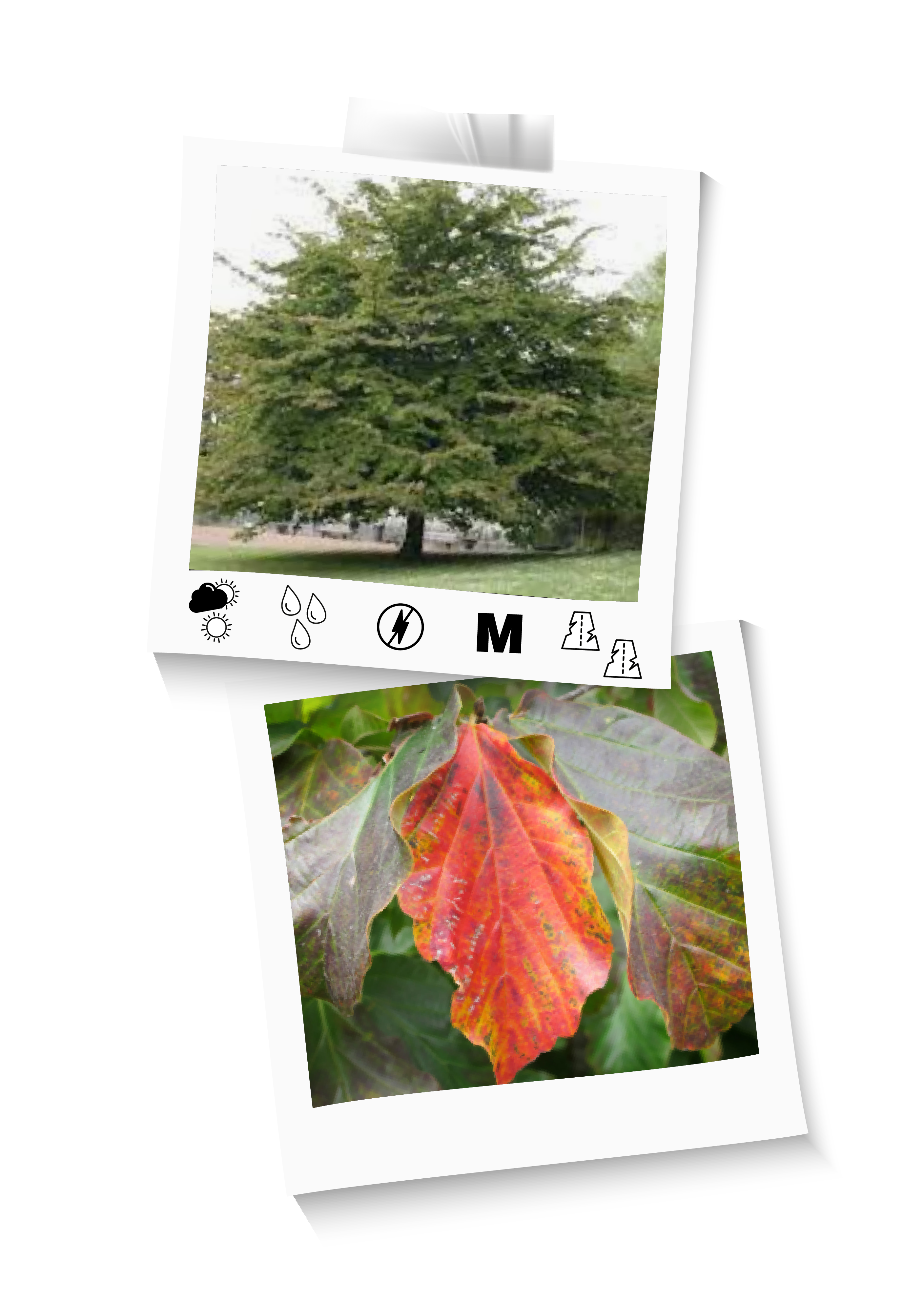
Photos taken at Dallas Arboretum – Dallas, TX, Los Angeles County Arboretum – Arcadia, CA, Strybing Arboretum – San Francisco, CA, San Luis Obispo, CA, Hoyt Arboretum – Portland, OR, Finch Arboretum – Spokane, WA and The National Arboretum – Washington, DC by M. Ritter, C. Stubler, W. Mark, J. Reimer
Site Conditions
- Planting area: 5’ to 10’
- Root Damage Potential : Moderate
- SelecTree Water Use: Medium
- USDA zones: 4, 5, 6, 7
- Sun exposure: Partial Shade to Full Sun
- Soil texture: Loam or Sand
- Soil pH: Acidic to Neutral
- Soil salinity tolerance: Moderate
- Powerline friendly: No
Tree Characteristics
- Tree Shape: Rounded
- Foliage type: Deciduous
- Maximum height: 35 feet
- Canopy width: 15-35 feet
- Growth rate: ~12-24 in/year
- Flowers: Showy
- Flower color: Red
- Flowering: Spring
- Fruit: Medium Capsule
- Fruiting: Summer or Fall
- Litter: Fruit
Site Consideration
Screen, Streetscape, Tree Specimen
Lagerstroemia indica ‘Powhatan’
Powhatan Crape Myrtle
Family Lythraceae
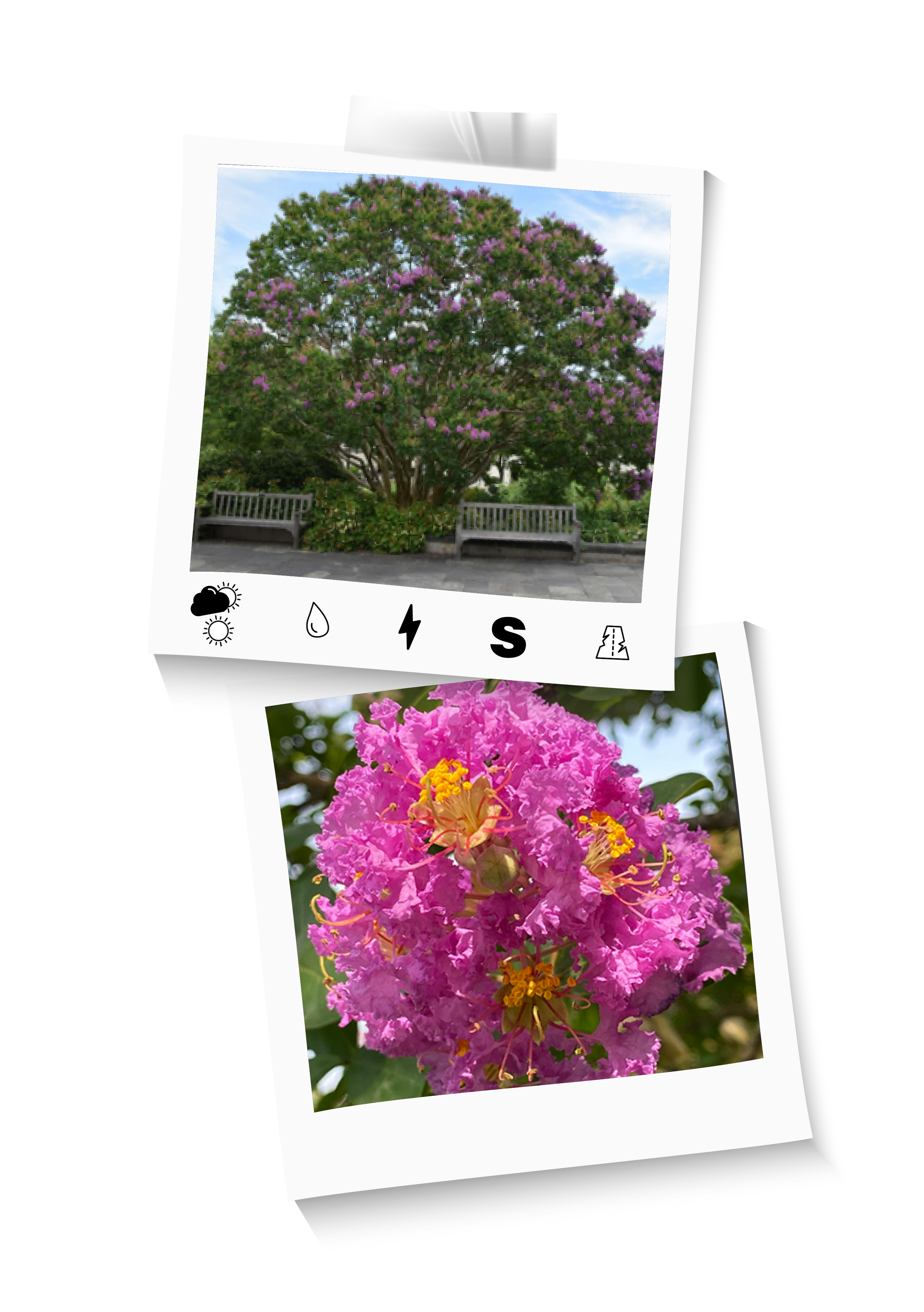
Photos taken at The National Arboretum – Washington, DC by C. Stubler, J. Reimer, W. Mark
Site Conditions
- Planting area: 2 – 5’
- Root Damage Potential: Low
- SelecTree Water Use: Very Low
- USDA zones: 7, 8, 9
- Sun exposure: Partial Shade to Full Sun
- Soil texture: Loam, Sand, or Clay
- Soil pH: Very Acidic to Slightly Alkaline
- Salt spray tolerance: Moderate
- Powerline friendly: Yes
Tree Characteristics
- Tree Shape: Rounded
- Foliage type: Deciduous
- Maximum height: 20 feet
- Canopy width: 8 – 12 feet
- Growth rate: ~24 in/year
- Flowers: Showy
- Flower color: Purple or Pink
- Flowering: Summer
- Litter: Dry Fruit Capsules
Site Consideration
Hedge, Screen, and Tree
Lagerstroemia ‘Seminole’
Seminole Crape Myrtle
Family Lythraceae

Photos taken at Independence Park Botanic Garden – Baton Rouge, LA and The National Arboretum – Washington, DC by Robert O’Brien, C. Stubler, J. Reimer, W. Mark
Site Conditions
- Planting area: 2’-5’
- Root Damage Potential: Low
- SelecTree Water Use: Very Low
- USDA zones: 7, 8, 9
- Sun exposure: Partial Shade to Full Sun
- Soil texture: Loam, Sand, or Clay
- Soil pH: Very Acidic to Slightly Alkaline
- Salt spray tolerance: Moderate
- Powerline friendly: Yes
Tree Characteristics
- Tree Shape: Rounded or Vase
- Foliage type: Deciduous
- Maximum height: 15 feet
- Canopy width: 6-15 feet
- Growth rate: ~24 in/year
- Flowers: Showy
- Flower color: Pink
- Flowering: Summer
- Litter: Dry Fruit Capsules
Site Consideration
Screen, Tree Specimen
Cotinus coggygria
Smoke Tree
Family Anacardiaceae
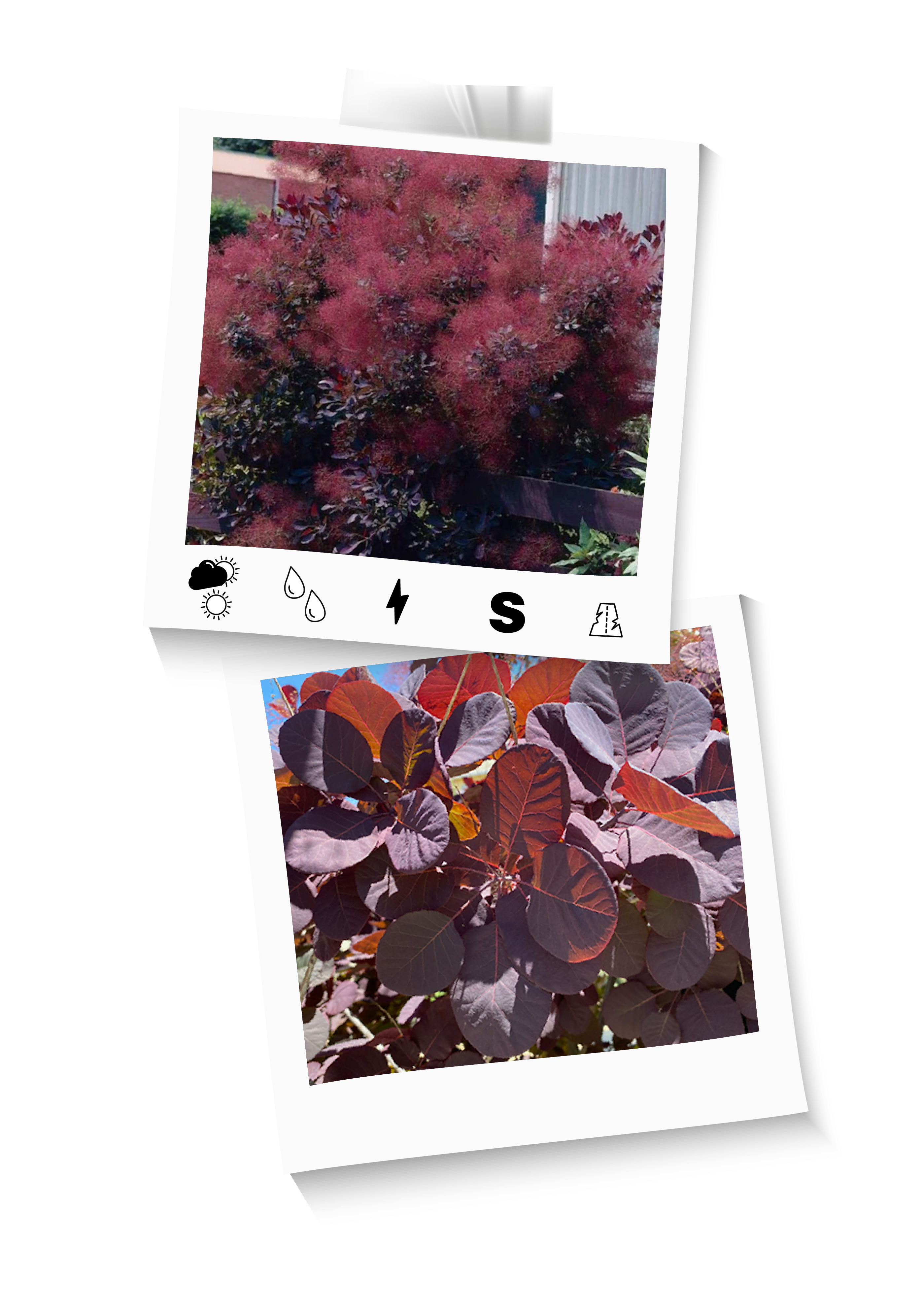
Photos taken at Cal Poly State University – San Luis Obispo, CA, The National Arboretum – Washington, DC and Finch Arboretum – Spokane, WA by M. Ritter, W. Mark, J. Reimer
Site Conditions
- Planting area: 2’ – 5’
- Root Damage Potential: Low
- SelecTree Water Use: Low
- USDA zones: 5, 6, 7, 8
- Sun exposure: Partial Shade to Full Sun
- Soil texture: Loam, Sand
- Soil pH: Very Acidic to Very Alkaline
- Soil salinity tolerance:Moderate Inland
- Powerline friendly: Yes
Tree Characteristics
- Tree Shape: Rounded
- Foliage type: Deciduous
- Maximum height: 15 feet
- Canopy width: 10 – 18 feet
- Growth rate: ~24 in/year
- Flowers: Showy
- Flower color: Purple
- Flowering: Spring
- Fruit: Very Small Pink Drupe
- Fruiting: Summer
- Litter: Dry Fruit
Site Consideration
Streetscape, Screen, and Tree Specimen
Cercis occidentalis
Western Redbud
Family Fabaceae
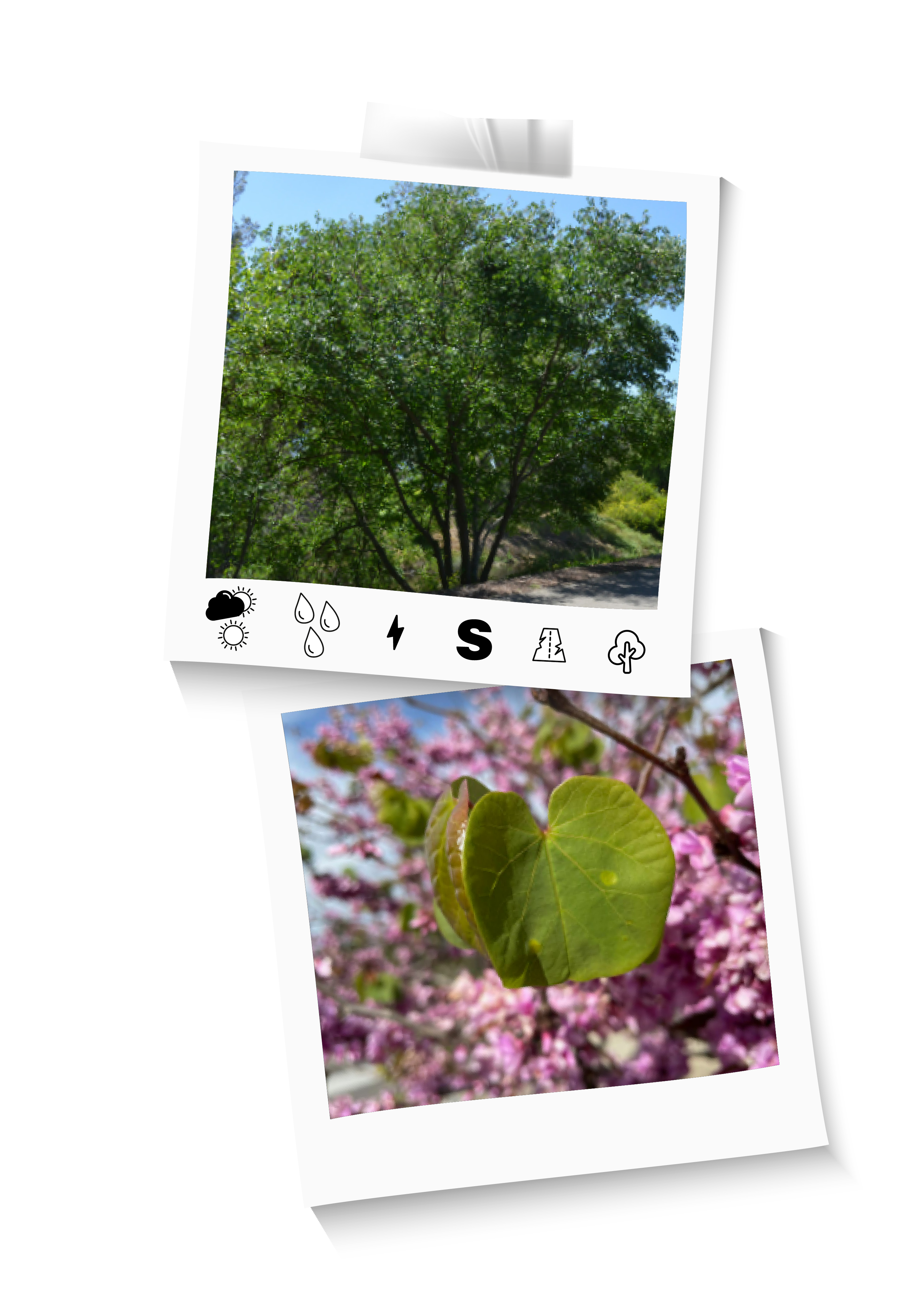
Photos taken at Leaning Pine Arboretum – Cal Poly San Luis Obispo, CA, Cal Poly State University – San Luis Obispo, CA, Santa Barbara Botanic Garden, Los Angeles County Arboretum – Arcadia, CA and UC Santa Cruz Arboretum – Santa Cruz, CA by Robert O’Brien, D. Lorenzo, J. Smith, M. Ritter, W. Mark, J. Reimer
Site Conditions
- Planting area: 2’-5’
- Root Damage Potential: Low
- SelecTree Water Use: Medium
- USDA zones: 7, 8, 9
- Sun exposure: Partial Shade to Full Sun
- Soil texture: Loam or Sand or Clay
- Soil pH: Very Acidic to Very Alkaline
- Salt spray tolerance: Moderate
- Powerline friendly: Yes
Tree Characteristics
- Tree Shape: Rounded
- Foliage type: Deciduous
- Maximum height: 20 feet
- Canopy width: 10-20 feet
- Growth rate: ~24-36 in/year
- Flowers: Showy
- Flower color: Purple
- Flowering: Spring
- Fruit: Brown Legumes
- Fruiting: Fall to Summer
- Fruit value: Wildlife use it
- Litter: Dry Fruit
Abies concolor
White Fir
Family Pinaceae
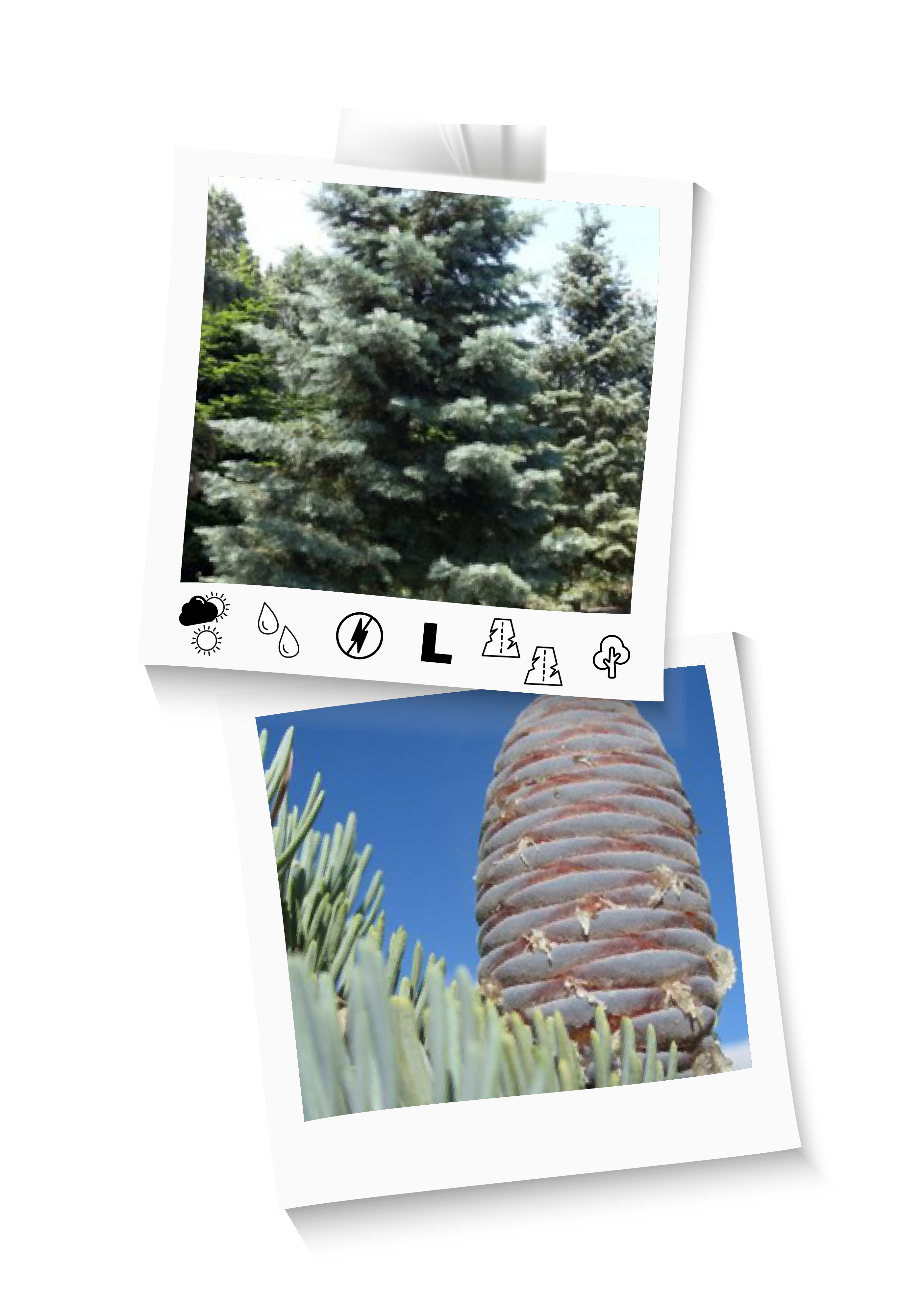
Photos taken at Kwantlen Polytechnic University, Langley, B.C., Grand Canyon, AZ, Red Butte Garden – Salt Lake City, UT, Regional Parks Botanic Garden, Tilden Regional Park – Berkeley, CA, Finch Arboretum – Spokane, WA and Hoyt Arboretum – Portland, OR by Blake Willson – TreeLib.ca, M. Ritter, W. Mark, J. Reimer
Site Conditions
- Planting area: 10’
- Root Damage Potential : Moderate
- SelecTree Water Use: Low
- USDA zones: 5, 6, 7
- Sun exposure: Partial Shade to Full Sun
- Soil texture: Loam, Sand, or Clay
- Soil pH: Very Acidic to Neutral
- Salt spray tolerance: Moderate
- Powerline friendly: No
Tree Characteristics
- Tree Shape: Conical
- Foliage type: Evergreen
- Maximum height: 50 feet
- Canopy width: 15-25 feet
- Growth rate: ~12-24 in/year
- Flowers: Fragrant
- Flowering: Spring
- Fruit: Large Purple Cone
- Fruiting: Fall or Winter
- Litter: Dry Fruit
Site Consideration
Parkland, Wildland, Tree Specimen

